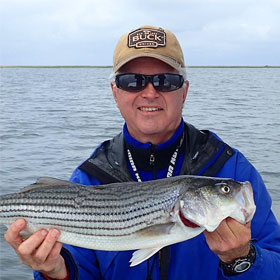Pontoon Fishing Tips and Pontoon Fishability: What You Should Know
By Ken Schultz
Jan 02, 2019
Pontoons boats are increasingly used for fishing. Here are the top considerations for pontoon boat fishability, and tips to maximize your pontoon fishing excursion.
Perhaps as you’ve looked through boating and fishing catalogs and sport shows you’ve noticed how popular pontoon boats are and thought about them as possible fishing vessels. More people are fishing out of this craft than ever, so if you’re considering this, here are some pontoon fishing tips and thoughts about pontoon-boat fishability.


Let’s specify that the pontoon fishing tips here refer to powered pontoon boats as opposed to unpowered float boats with pontoons used by a single person for small-water fishing. Modern pontoon boats (which need to be registered like any other powerboat) can run fast and far, and their general stability and roominess makes them good for a group, a family, teaching children to fish from a stable platform, bringing the dog along, or, in some cases, having a barbecue onboard while catching fish.


If you’re in the market for a fishing pontoon, think about these pontoon fishing tips and thoughts about fishability:
- Most pontoons are not set up for fishing. Look for ones that are, because they’ll have accessories and considerations that make them more suitable for angling. Alternatively, you can set one up for fishing, or order factory add-ons for a boat you’re ordering.
- Special considerations of most importance include rod holders, a livewell or baitwell, and a bow-mounted electric motor.
- Rod holders are probably the biggest concern to address. That includes upright holders for the rods while in transit, but especially rail-mounted holders for bait and bottom-fishing. Clamp-on models are okay for catching smaller species, but you need sturdy bolt-on versions if you expect to catch large fish (like stripers or catfish). Track-mounted holders are another installation option.
- Consider where you’ll be going. Pontoon boats are best in calm waters, worst in big-wave environments. Most are fine in a chop or moderate waves, but in big seas the decks can get washed over, bang waves, and produce a lot of spray. As a general rule, calmer waters, back bays, and fishing in moderate winds are best for pontoons.
- Be aware of the susceptibility of pontoons to wind, in part because of their overall size, boxiness, and freeboard, but also because of canopies and tops, which many have. Drift fishing in a pontoon is very popular, but control and positioning are hampered by wind, which may require you to anchor.
- One of the best pontoon fishing tricks I’ve seen was the use of a large, heavy ring tied to a rope for holding fast to stumps. The ring was easy to flip over the stump and to disengage later on, so you didn’t get an anchor hung up or have to lean out of the boat to deploy it.
- If you add a livewell you have to think about how to get water in and out of it, if the boat does not come equipped for that. Using a bucket to fill a livewell gets old fast. Plus you’ll need to aerate the water.
- You may need a long-handled net to bring larger species onboard, since pontoons are surrounded by fencing, meaning that a fish has to be lifted several feet from the water to clear the fencing. It’s not always possible to bring a larger fish around to a front or rear rail door where there’s a lower entry point, so a long-handled net is helpful.









